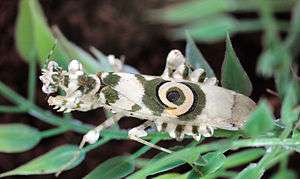Pseudocreobotra wahlbergi
| Pseudocreobotra wahlbergi | |
|---|---|
 | |
| Spiny Flower Mantis adult | |
| Scientific classification | |
| Kingdom: | Animalia |
| Phylum: | Arthropoda |
| Class: | Insecta |
| Order: | Mantodea |
| Family: | Hymenopodidae |
| Genus: | Pseudocreobotra |
| Species: | P. wahlbergi |
| Binomial name | |
| Pseudocreobotra wahlbergi Stål, 1871 | |
Pseudocreobotra wahlbergi, or spiny flower mantis, is a small Flower Mantis (1.5 inches or 38 millimetres) native to southern and eastern Africa.
Appearance
The adult has spiny structures on the underside of its abdomen, giving it its name. It is variable in colour, being typically greenish, but it can equally be yellowish, pinkish, or reddish. It has a striking spiral "9" mark on its forewings providing a conspicuous eyespot in black, green and cream surrounded by a green patch. The hind wings are orange on the inner part and transparent on the outer part. Nymphs start out black, similar to ants
Sexual Dimorphism
While very similar, female, and male spiny flower mantids can be told apart. Females have small spines by the edges of their elytra and six to seven segments on their abdomen. Females also tend to have slightly shorter antennae, longer wings, and take seven moults to reach maturity. On the other hand, males do not have the spines on their elytra, have eight abdominal segments, shorter wings, longer antennae and will take six moults to reach maturity[1]
Behaviour and Ecology
P. wahlbergi has a deimatic display in which it spreads its forewings, making itself appear larger and prominently displaying its eyespots to startle would-be predators. While at rest it is well camouflaged, and is a sufficiently good aggressive mimic of a flower that prey insects can attempt to pollinate it, at which moment the mantis seizes and eats them. They tend to eat flying insects and spiders but can eat almost any insect if hungry.
Environmental Conditions
The species is common in captivity and is easy to rear. In the wild the mantis lives at temperatures from 25 °C to 30 °C (77 °F to 86 °F) during the day. At night, it can handle a lower temperature of at least 18 °C (64.4 °F).
While P. wahlbergi is tolerant to a range of humidity - with an ideal humidity of 60% - but too much moisture can be fatal to the mantis as it is able to cause infections. They need water often but can get most of it from the prey they eat.[2]
After breeding, the female can eat her mate because, like with most mantis species, they are cannibalistic. Nymphs up to their fourth instar are not cannibalistic. The female lay egg cases (ootheca) almost three times its size,[3] and will usually hatch between 30 to 50 offspring.[4] Ootheca survive in the same conditions as the mantis.
See also
References
- ↑ "8 Facts About the Spiny Flower Mantis". 2014-03-20. Retrieved 2018-03-22.
- ↑ "Spiny Flower Mantis - Pseudocreobotra wahlbergii | Keeping Insects". www.keepinginsects.com. Retrieved 2018-03-21.
- ↑ Deadly Mantis. Retrieved 13 May 2013.
- ↑ "Pseudocreobotra Wahlbergii (Spiny Flower Mantis) - Insectstore - Live Insect Store for praying mantids, ootheca & stick insects". Insectstore - Live Insect Store for praying mantids, ootheca & stick insects. Retrieved 2017-04-01.